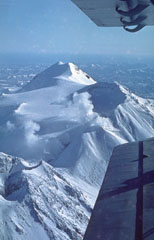Report on Zhupanovsky (Russia) — 13 January-19 January 2016
Smithsonian Institution / US Geological Survey
Weekly Volcanic Activity Report, 13 January-19 January 2016
Managing Editor: Sally Sennert.
Please cite this report as:
Global Volcanism Program, 2016. Report on Zhupanovsky (Russia) (Sennert, S, ed.). Weekly Volcanic Activity Report, 13 January-19 January 2016. Smithsonian Institution and US Geological Survey.
Zhupanovsky
Russia
53.589°N, 159.15°E; summit elev. 2899 m
All times are local (unless otherwise noted)
Based on visual observations, KVERT reported that at 1636 on 19 January an explosion at Zhupanovsky generated an ash plume that rose to altitudes of 7-8 km (23,000-26,200 ft) a.s.l. and drifted 20 km E. The Aviation Color Code was raised to Orange (the second highest on a four-color scale).
Geological Summary. The Zhupanovsky volcanic massif consists of four overlapping stratovolcanoes along a WNW-trending ridge. The elongated complex was constructed within a Pliocene-early Pleistocene caldera whose rim is exposed only on the eastern side. Three of the stratovolcanoes were built during the Pleistocene. An early Holocene stage of frequent moderate and weak eruptions from 7,000 to 5,000 years before present (BP) was followed by a period of infrequent larger eruptions that produced pyroclastic flows. The last major eruption took place about 800-900 BP. Recorded eruptions have consisted of relatively minor explosions from Priemysh, the third cone from the E about 2.5 km from the summit peak.

